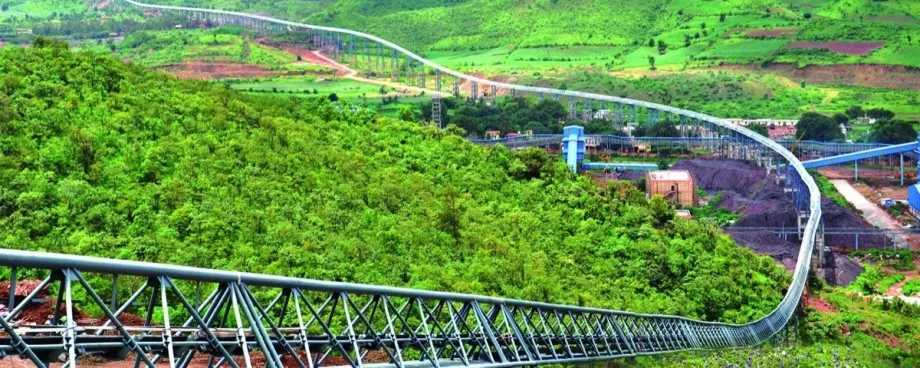Braking Modes and Philosophy
Motors and VFD
- It should be emphasized that the normal mode of stopping the conveyor is a controlled stop using the drive’s VFD control system, which is the inverse of the starting S-curve. After the conveyor come to a complete standstill the brakes are applied.
Normal Braking
- In the event of power failure, the conveyor is brought to rest as i) above using the VFD drives which is equipped with a battery back-up system
- In the event of VFD failure the braking system stops the conveyor according to a pre-programmed speed “S-curve”. Should the power fail at the same time the UPS back-up would maintain the control functionality for the braking system during the stop.
Emergency Braking
- If the brake controller and VFD drives are unavailable, together with a power failure and the UPS fails, the digital brake calipers apply immediately and the proportional brake calipers then apply slowly until full load based on the torque measured before the unit failures.
Over Speed Braking
- When the over speeding occurs and the VFD`s are unavailable, the brake controller initiates a controlled stop using the digital and proportional braking systems.
See Table 5 for different braking scenarios.
| Mode of braking | Total braking torque 4 calipers [kNm] | Braking time [s] | Total braking torque 2 calipers [kNm] | Braking time [s] | |||
|---|---|---|---|---|---|---|---|
| Digital | Proportional | Digital | Proportional | ||||
| Empty | With motors & VFD | – | – | – | – | – | – |
| Normal braking (in case of power failure, with UPS active) | 0 | 7.3 | 60 | 0 | 7,3 | 60 | |
| Emergency stop (in case of power failure & brake controller PLC failure) | 130.4 | 130.4 | 7.66 | 65.2 | 65.2 | 13.9 | |
| 25% Over speeding of conveyor | 130.4 | 130.4 | 9.2 | 65.2 | 65.2 | 16.1 | |
| Fully loaded | With notors & VFD | – | – | – | – | – | – |
| Normal brakes (in case of power failure, with UPS active) | 130.4 | 8,6 | 60 | 65.2 | 65.2 | 68.4 | |
| Emergency stop (in case of power failure & brake controller PLC failure | 130.4 | 130.4 | 21.86 | 65.2 | 65.2 | 68.4 | |
| 25% Over speeding of conveyor | 130.4 | 130.4 | 26.23 | 65.2 | 65.2 | 82.11 | |
| Downhill loaded | With motors & VFD | – | – | – | – | – | – |
| Normal braking (in case of power failure, with UPS active) | 130.4 | 74.9 | 60 | 65.2 | 65.2 | 2 Calipers cannot brake the conveyor, however it will eventually stop on the up hill section. |
|
| Emergency stop (in case of power failure & brake controller PLC failure) | 130.4 | 130.4 | 27.3 | 65.2 | 65.2 | ||
| 25% Over speeding of conveyor | 130.4 | 130.4 | 38.9 | 65.2 | 65.2 | ||
Start Up Procedure
The conveyor start is controlled by variable speed drives. The inverter start-cycle will be 150 seconds long, however 10% belt speed will be maintained for 20 seconds prior to introducing the start up control loop. It is first necessary to start releasing the brake under a controlled condition prior to engaging the drive motors.
The tail drive pulley is brought to full speed in 150 seconds following a delayed “S” shaped velocity curve as can be seen in Fig. 17. The delay is to make sure the head and tail pulleys speeds are synchronized.
As the conveyor is regenerative under some load conditions and therefore the brakes will apply at zero speed.
Conclusion
This paper shows all the design parameters on how to go about designing complex high-speed regenerative conveyors consisting of horizontal curves.
With this conveyor pushing every design component to the next level, one can say design codes and standards only provide a guideline, they don’t dictate the design.
■








